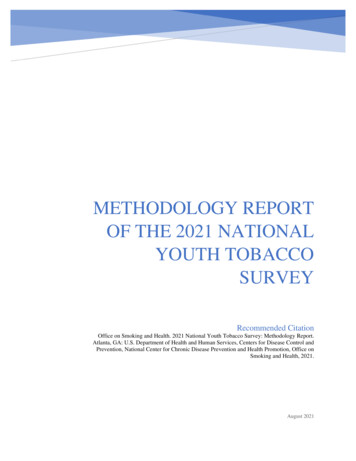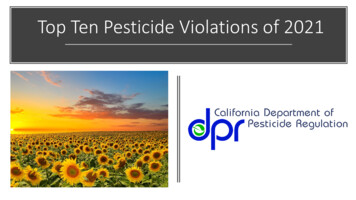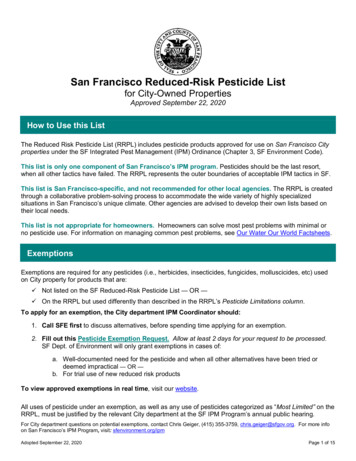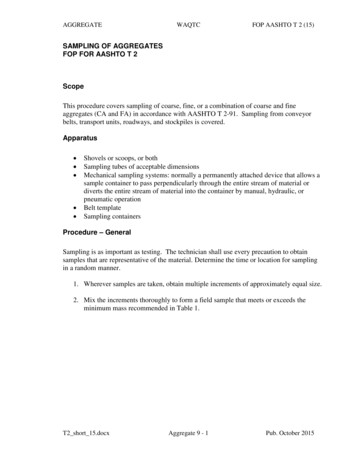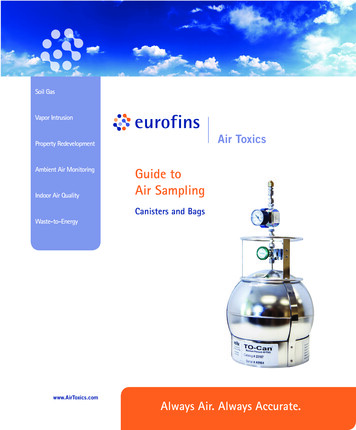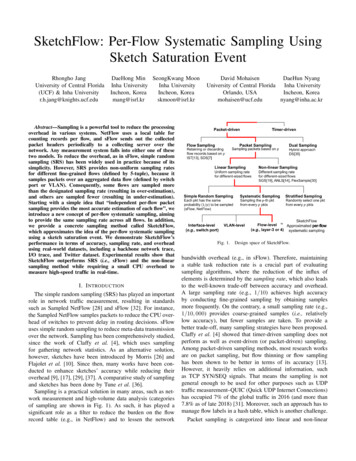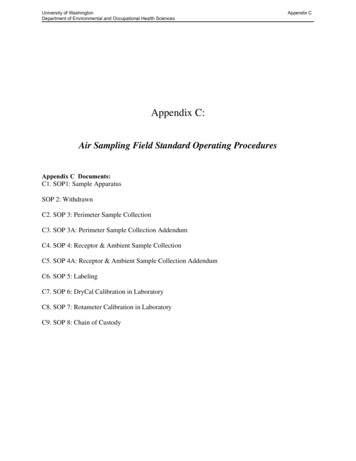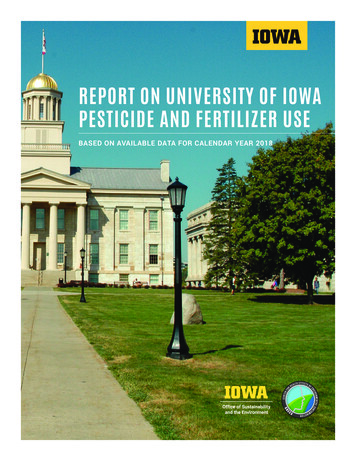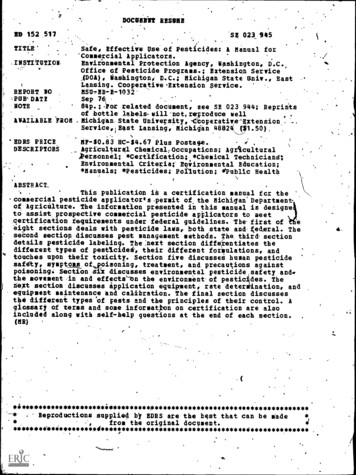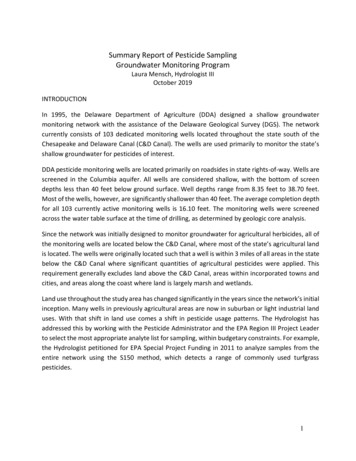
Transcription
Summary Report of Pesticide SamplingGroundwater Monitoring ProgramLaura Mensch, Hydrologist IIIOctober 2019INTRODUCTIONIn 1995, the Delaware Department of Agriculture (DDA) designed a shallow groundwatermonitoring network with the assistance of the Delaware Geological Survey (DGS). The networkcurrently consists of 103 dedicated monitoring wells located throughout the state south of theChesapeake and Delaware Canal (C&D Canal). The wells are used primarily to monitor the state’sshallow groundwater for pesticides of interest.DDA pesticide monitoring wells are located primarily on roadsides in state rights-of-way. Wells arescreened in the Columbia aquifer. All wells are considered shallow, with the bottom of screendepths less than 40 feet below ground surface. Well depths range from 8.35 feet to 38.70 feet.Most of the wells, however, are significantly shallower than 40 feet. The average completion depthfor all 103 currently active monitoring wells is 16.10 feet. The monitoring wells were screenedacross the water table surface at the time of drilling, as determined by geologic core analysis.Since the network was initially designed to monitor groundwater for agricultural herbicides, all ofthe monitoring wells are located below the C&D Canal, where most of the state’s agricultural landis located. The wells were originally located such that a well is within 3 miles of all areas in the statebelow the C&D Canal where significant quantities of agricultural pesticides were applied. Thisrequirement generally excludes land above the C&D Canal, areas within incorporated towns andcities, and areas along the coast where land is largely marsh and wetlands.Land use throughout the study area has changed significantly in the years since the network’s initialinception. Many wells in previously agricultural areas are now in suburban or light industrial landuses. With that shift in land use comes a shift in pesticide usage patterns. The Hydrologist hasaddressed this by working with the Pesticide Administrator and the EPA Region III Project Leaderto select the most appropriate analyte list for sampling, within budgetary constraints. For example,the Hydrologist petitioned for EPA Special Project Funding in 2011 to analyze samples from theentire network using the S150 method, which detects a range of commonly used turfgrasspesticides.1
Delaware Department of Agriculture Pesticide SectionGroundwater Monitoring Network Well Locations (2019)2
GOAL OF PROGRAMThe DDA Hydrologist conducts annual groundwater sampling activities utilizing the statewidenetwork of shallow monitoring wells. These wells are located throughout the region of the state(the portion of the state located south of the Chesapeake and Delaware Canal) that utilizesgroundwater as the sole drinking water source.The purpose of the DDA’s monitoring network is to monitor the state’s shallow groundwater forpesticides of interest that are registered for use in the state. The Hydrologist works with thePesticide Administrator and the EPA Region III Project Leader to determine the optimal strategy forsampling each year. This strategy includes assessing which compounds can be included inlaboratory analysis within the limits of budget and other resources. Currently, the analyte list isdetermined largely by the list of Pesticides of Interest (POIs), delineated in the EPA’s Pesticides ofInterest National Tracking System (POINTS). In addition to analyzing for POIs, additionalcompounds can be added to the analyte list after deliberation with the aforementioned parties.Since 2007, the EPA has been operating a web-based Pesticides of Interest National TrackingSystem (POINTS). States, tribes, and territories are obliged to evaluate each of the 57 Pesticides ofInterest (POI) active ingredients based on the respective level of concern for each POI.This list of 57 compounds was originally compiled from results from a nationwide survey of FIFRA(Federal Insecticide, Fungicide, and Rodenticide Act) state lead agencies (SLAs). The DDA PesticideSection is the SLA for Delaware. These 57 compounds were found to be of greatest concern forFIFRA SLAs across the nation. The EPA then tasked each state’s FIFRA SLA to evaluate the entirePOINTS compound list based each state’s respective concerns about the compounds in that state.The DDA Pesticide Section must therefore use a variety of evaluation tools to determine itsrespective levels of concern about each POI active ingredient. One of these evaluation tools isgroundwater monitoring. Because a majority of the state’s population (65%) depends ongroundwater for drinking water, Delaware emphasizes the value of groundwater monitoring forevaluating the risks of individual pesticides.The Hydrologist and Pesticide Administrator have determined that alachlor, atrazine, metolachlor,and simazine are Pesticides of Concern (POCs) in Delaware, mainly due to their widespread use inthe state and their potential for contamination of the shallow groundwater. As part of POINTS,POCs must be “actively managed,” and a large part of this active management conducted by theDDA involves yearly monitoring of these four compounds across the monitoring well network.3
SAMPLE METHODOLOGYDuring the 2018-2019 sampling season, the Hydrologist obtained groundwater samples for analysisusing the EPA 525.2 method. Groundwater sampling activities were conducted in accordance withthe Section’s Quality Assurance documents, including the Quality Management Plan (2013),Groundwater Standard Operating Procedure (SOP) document (Mensch, 2019), and GroundwaterQuality Assurance Project Plan (QAPP) (Mensch, 2019).Wells are purged using an electric submersible pump run on a Geotech rechargeable 12 V fieldbattery. Purge water is run through a flow cell where chemical parameters such as pH, electricalconductivity, and temperature are monitored at 5 minute intervals. Once the chemical parametershave stabilized a sample is collected using the laboratory’s sample bottle. For most analyticalmethods previously used, this bottle consists of a 1 liter amber glass bottle with preservatives(added by laboratory personnel prior to acquisition by the Hydrologist). Sample bottles are labeledwith the date, location, time of collection, and analytical method to be used. Samples are kept in adedicated low residue groundwater sample cooler on ice until transfer to a locked low residuerefrigerator. The Hydrologist coordinates with the laboratory to ensure that samples are deliveredwell within the analytical method’s holding period.LABORATORY ANALYSISGroundwater samples were analyzed using the EPA Drinking Water 525.2 method. This method isused primarily to detect the presence of semivolatile compounds (SOCs) in drinking water,including alachlor, atrazine, metolachlor, and simazine. The Hydrologist submitted groundwatersamples for laboratory analysis to QC Laboratories in Southampton, PA. A full analyte list, includingrespective Minimum Reporting Limits (MRLs), is located for reference in the appendix.4
RESULTSStatewide Results: Alachlor was not detected in any of the samples. Atrazine was detected in 6% of the wells, metolachlor in 2% and simazine in 3%.Statewide Percentage of Samples withDetections By Compound 2018-20197Percentage of Samples6543210AtrazineMetolachlorSimazine Atrazine levels across monitoring well network broken down by concentration range (ppb):2018-19 AtrazineConcentration RangesNot detected0.1-0.50 ppb0.51-1.0 ppbReporting Limit (RL) 0.10 ppbNon-detects Below RL of 0.10 ppbppb Parts per Billion5
network of shallow monitoring wells. These wells are located throughout the region of the state (the portion of the state located south of the Chesapeake and Delaware Canal) that utilizes groundwater as the sole drinking water source. The purpose of the DDA's monitoring network is to monitor the state's shallow groundwater for
